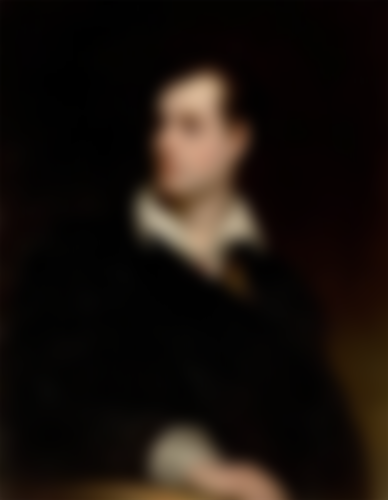Lord Byron (1788-1824) and Percy Bysshe Shelley (1792-1822) lived a long time in a sort of ménage à trois, together with Shelley's wife, Mary Shelley, the author of Frankenstein. It ended with Shelley's death under unclear circumstances; he drowned in Lake Geneva. Doubtlessly, these three artistically inspired one another. Frankenstein, Mary's most famous work, was a direct result of their story telling during dark nights. Even if Mary is not our subject this time, there is a story about how Shelley's dead body was treated that exposes the atmosphere of dramatic romanticism these three lived in.
(Below: Portrait of Lord Byron (1788–1824). Painting by Thomas Phillips. Public Domain. Original at Newstead Abbey, the ancestral home of Lord Byron.)

At the beach of Lake Geneva where Shelley's corpse was washed up, Lord Byron and Edward Trelawny burnt it. (Some sources claim that Leigh Hunt was present as well, but he wasn't. Neither was Shelley's widow, Mary, although both can be seen on Louis Édouard Fournier's painting below.) Byron wanted the skull, but Trelawny refused to let him have it. Strangely, the heart didn't burn, and Trelawny took it out from the fire (hurting his hands, which became a constant source of pain for many years), gave it to Hunt, who later gave it to Mary (Shelley's widow). As a widow she carried it with her everywhere in a silken shroud. Put in a silver case, it was later buried with their son.

(Above: The Funeral of Shelley by Louis Édouard Fournier (1889). Oil on canvas. Public Domain. Original at Walker Art Gallery, Liverpool. From left, Trelawny, Hunt, and Byron. The painting is not historically accurate. Hunt did not observe the cremation and Mary Shelley, who is pictured kneeling at the left side, did not attend.)
Byron and Shelley, two heroes of English poetry, got their inspiration from many sources; no doubt, one of them was the Egyptomania of the time. Yet they didn't know much about Egypt, and, at least Shelley, had never been there. Probably not Byron either, although that is not certainly known. But Egypt, or the popular image of Egypt, thrilled their imagination, just as it did the imagination of almost every other poet and author of their time.
What are the hopes of a man? Old Egypt’s King of Cheops erected the first pyramid
And largest, thinking it was just the thing
To keep his memory whole, and mummy hid;
But somebody or other rummaging,
Burglariously broke his coffin’s lid
Let not a monument give you or me hopes,
Since not a pinch of dust remain of Cheops.
(Lord Byron)
It is beyond doubt that Shelley never visited Egypt, but he didn't escape Egyptomania. As in Ozymandias, 1818:
I met a traveller from an antique land
Who said: Two vast and trunkless legs of stone
Stand in the desert. Near them, on the sand,
Half sunk, a shattered visage lies, whose frown
And wrinkled lip, and sneer of cold command
Tell that its sculptor well those passions read
Which yet survive, stamped on these lifeless things,
The hand that mocked them and the heart that fed.
And on the pedestal these words appear:
"My name is Ozymandias, king of kings:
Look on my works, ye Mighty, and despair!"
Nothing beside remains. Round the decay
Of that colossal wreck, boundless and bare
The lone and level sands stretch far away.
(Ozymandias, Percy. Bysshe Shelley)
The poem refers to Ramses II, whose Greek name is Ozymandias, from User-maat-re Setep-en-re, his throne name. Literature frequently claims that it was inspired by a statue of Ramses arriving to Britain, but Shelley was not there when it came and he probably never saw it. The description also conveys a definite impression of Shelley never having seen a genuine Egyptian statue of a Pharaoh. The poem contains fundamental erroneous details.
Still, it is one of Shelley's finest poems, a product of imagination rather than history, whose true meaning is something else entirely – how creativity survives while tyranny does not. After all, the statue of Ramses can still be seen; it is the statue, the work of art, whose impact still lingers after millennia, while Ramses is nothing more than the motive of the statue, the subject of a work of art.
Related articles:
Aleisteir Crowley & Egypt: The Stele of Revealing & The Book of the Law
Lovecraft was More than Horror
Egyptomania & Horror Literature, where I define Egyptomania.
Copyright © 2020, 2021 Meleonymica/Mictorrani. All Rights Reserved.
Here you find my articles related to literature, and here to egyptology.
For history, legends and myths, join my community History, Myths, Legends & Mysteries (be45).
You find all my writings on Read.Cash, sorted by topic, here.


"Ozymandias" was how I regarded the Maḥram Bilqis.
How it loomed out of the sand after a recent, massive, sandstorm when returning from the Rub' al Khali suggested the demise of a doomed deity.
Local drivers we hired (from Sanaa) were terrified of the place and would not stop to let us look.